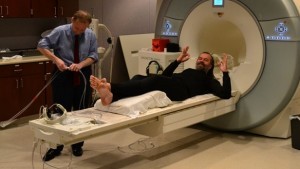Wim Hof is an “extreme athlete” from the Netherlands, best known for his apparently superhuman ability to withstand intense cold for extended periods of time. But is it a genuine physical skill that can be learned, or is the self-proclaimed “Iceman” more of a modern-day Houdini? To observe what might be going on in his brain and body, scientists from Wayne State University have now run a series of scans during these icy exposures.
Hof’s resumé reads like that of a classic stuntman or illusionist. He claims to hold (or have once held) 21 Guinness World Records, for things like running the fastest half marathon barefoot on snow and holding his breath for six minutes beneath the ice of the North Pole. He’s also climbed to an altitude of 24,000 ft (7.4 km) up Mount Everest wearing just boots and shorts, and performed other physical endurance feats like dangling from one finger between two hot air balloons at an altitude of 4,900 ft (1.5 km).
Hof attributes his abilities to what he calls the Wim Hof Method, which involves a series of short, sharp breaths to induce a kind of controlled hyperventilation. And of course, you can learn how to do the same if you buy his book and attend his life coaching classes. But is this a case of showy charlatanism, or is there a real physiological phenomenon behind it?
To find out, the Wayne State researchers ran scans of Hof’s brain and body functions as he performed his method while exposed to cold. Over the course of three days, the team studied Hof using two different imaging techniques. They observed his brain using functional magnetic resonance imaging (fMRI), and used positron emission tomography (PET) to watch what was happening in his muscles.
By having Hof wear a special bodysuit, the researchers were able to pump chilled or warmed water around his body, cycling him through mild hypothermia interspersed with periods at a normal body temperature. To test the effects of the Wim Hof Method, the team had the Iceman perform the breathing exercises only before one scan, and compared the results to a control run without the exercises beforehand. His results were also compared to a control group of other participants.
The researchers found that even when exposed to the cold, the temperature of Hof’s skin remained relatively unchanged. The PET scans suggested that the intense breathing was warming blood in the capillaries in his lungs, which was then circulating better through his body. There was an increase in his sympathetic innervation and glucose consumption in the intercostal muscle, and the fMRI scans also revealed increased activity in an unexpected region of the brain.
“The willful regulation of skin temperature — and, by implication, core body temperature, even when the body is being stressed with cold — is an unusual occurrence and may explain his resistance to frostbite,” says Otto Muzik, one of the researchers on the project. “From our previous studies, we expected the Iceman to show significant brain activations in a region known as the anterior insula, where the brain’s higher thermoregulatory centers are located. However, we observed more substantial differences in an area called periaqueductal gray matter, located in the upper brainstem. This area is associated with brain mechanisms for the control of sensory pain and is thought to implement this control through the release of opioids and cannabinoids.”
The researchers conclude by saying they’re intrigued to explore the potential applications of the Wim Hof Method in medicine and treatment. To us, it smacks a little of New Age hokum, but the Iceman’s abilities do seem to be reasonably well-documented. While Wim Hof is certainly a curiosity, we’d still proceed with caution before parting with too much money trying to learn his ways.
Source: newatlas
Ask me anything
Explore related questions





